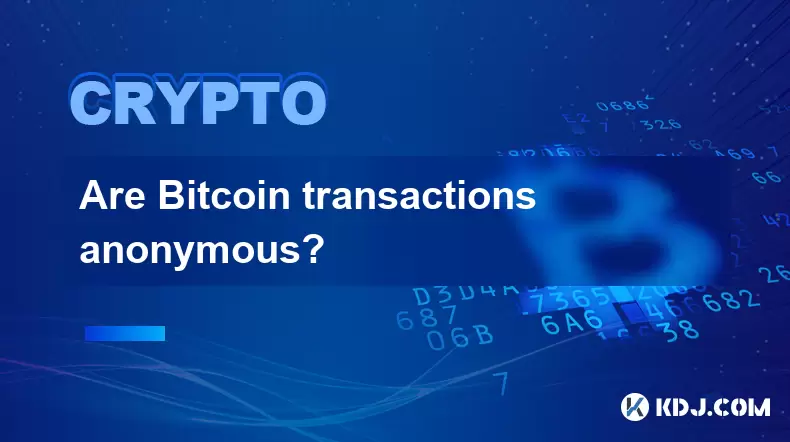-
 bitcoin
bitcoin $114684.631706 USD
-0.87% -
 ethereum
ethereum $4228.677447 USD
1.58% -
 bnb
bnb $1294.880693 USD
-1.16% -
 tether
tether $1.000819 USD
-0.02% -
 xrp
xrp $2.605138 USD
2.79% -
 solana
solana $209.908690 USD
5.89% -
 usd-coin
usd-coin $0.999903 USD
-0.03% -
 dogecoin
dogecoin $0.213423 USD
2.93% -
 tron
tron $0.322721 USD
-0.10% -
 cardano
cardano $0.727247 USD
3.66% -
 hyperliquid
hyperliquid $42.339456 USD
6.05% -
 chainlink
chainlink $19.910811 USD
5.16% -
 ethena-usde
ethena-usde $1.000557 USD
0.00% -
 stellar
stellar $0.349734 USD
2.69% -
 bitcoin-cash
bitcoin-cash $543.848687 USD
-0.21%
Are Bitcoin transactions anonymous?
Bitcoin transactions are pseudonymous, offering privacy through cryptographic keys but risking exposure if wallet addresses link to real-world identities via exchanges or analytics tools.
Jul 07, 2025 at 10:00 am

Understanding Bitcoin Transactions and Privacy
Bitcoin transactions are often described as pseudonymous rather than fully anonymous. This means that while a user’s real-world identity is not directly attached to a transaction, it can potentially be linked through analysis of the blockchain. Each transaction is recorded on a public ledger, accessible to anyone, and includes details such as sender, receiver, and amount transferred. However, these details are tied to wallet addresses rather than personal identities.
The concept of pseudonymity in Bitcoin stems from the use of cryptographic keys. Every Bitcoin wallet has a public key (address) and a private key. The public key is used to receive funds, and the private key is required to authorize outgoing transactions. Since these keys do not inherently contain personal information, users can remain relatively anonymous if they take precautions.
However, this anonymity can be compromised if a wallet address is associated with a real-world identity. For instance, if someone uses the same wallet address across multiple platforms or links it to an email, phone number, or social media profile, it becomes easier for observers to trace their activity.
How Blockchain Analysis Can Reveal Identities
Blockchain explorers allow anyone to look up transactions associated with a particular Bitcoin address. If an individual’s address is known, all their transaction history can be viewed. Advanced analytics tools used by companies like Chainalysis or Elliptic can track patterns in transactions, helping identify users even without direct personal data.
One method analysts use is called cluster analysis, which groups together addresses likely controlled by the same entity. When one address in the cluster is identified (e.g., because it interacts with a regulated exchange), the rest may also be traced. Additionally, timing analysis can help link transactions based on when they occur, especially when large movements happen simultaneously.
Even though Bitcoin transactions are decentralized and encrypted, the transparency of the blockchain makes it possible for determined entities—such as law enforcement agencies or cybersecurity firms—to de-anonymize users under certain conditions.
The Role of Exchanges in Reducing Anonymity
Most people buy Bitcoin through centralized exchanges, which typically require Know Your Customer (KYC) procedures. These regulations mandate that exchanges collect personal identification information from users, including government-issued IDs, selfies, and sometimes proof of address.
Once a wallet address is linked to a KYC-verified account on an exchange, the anonymity of that address is effectively eliminated. Law enforcement can request transaction records tied to that account, and in many jurisdictions, exchanges are legally obligated to comply with such requests.
Some users attempt to bypass this by using peer-to-peer platforms or privacy-focused exchanges that don’t enforce KYC. While this can increase anonymity, it also comes with risks, including potential scams, limited liquidity, and lack of legal recourse in case of disputes.
Techniques to Enhance Transaction Privacy
For those seeking greater anonymity, several techniques can be employed:
- Use new addresses for every transaction: Reusing the same Bitcoin address increases the risk of linking multiple transactions to a single owner.
- Utilize mixing services (tumblers): These services mix a user’s coins with others to obscure the transaction trail. However, some tumblers have been flagged by compliance tools, and using them may raise suspicion.
- Employ privacy wallets: Certain wallets offer enhanced privacy features, such as integration with CoinJoin protocols or support for confidential transactions.
- Avoid linking wallet addresses to personal accounts: Never share your wallet address publicly in association with your name or other identifying information.
- Use Tor or a VPN when transacting: This helps hide your IP address from network observers, reducing metadata leaks.
Each of these strategies contributes to increasing the difficulty of tracing a Bitcoin transaction back to a real-world identity.
Limitations of Bitcoin Anonymity Tools
Despite efforts to enhance privacy, no method is foolproof. Mixing services, for example, may keep logs or fail to adequately break the transaction chain. Some wallets claim to offer privacy but may still expose metadata or interact with transparent blockchains.
Regulatory pressure continues to grow around cryptocurrency transactions. Governments are increasingly requiring service providers to implement tracking mechanisms and report suspicious activities. As a result, tools that once provided plausible deniability may now be flagged by compliance systems.
Furthermore, the development of artificial intelligence and machine learning tools has enabled more sophisticated blockchain surveillance. Even small mistakes, such as reusing an address or transacting during a specific time window, can compromise anonymity.
Frequently Asked Questions
Q: Does using a hardware wallet make Bitcoin transactions more anonymous?A: Hardware wallets improve security but do not inherently increase anonymity. They protect private keys from being stolen, but transactions still appear on the public blockchain. To enhance anonymity, combine hardware wallet usage with other privacy practices.
Q: Can I completely anonymize my Bitcoin transactions?A: Complete anonymity is extremely difficult to achieve due to the transparent nature of the Bitcoin blockchain. However, combining best practices—like using fresh addresses, avoiding KYC exchanges, and leveraging privacy tools—can significantly reduce traceability.
Q: Are there cryptocurrencies more private than Bitcoin?A: Yes, several cryptocurrencies like Monero (XMR) and Zcash (ZEC) offer stronger privacy features by default. These networks use advanced cryptographic techniques such as ring signatures and zero-knowledge proofs to obscure transaction details.
Q: Is it illegal to try to make Bitcoin transactions anonymous?A: In most jurisdictions, using privacy-enhancing tools is not illegal. However, doing so may attract attention from regulators or financial institutions. Always ensure compliance with local laws and avoid engaging in illicit activities.
Disclaimer:info@kdj.com
The information provided is not trading advice. kdj.com does not assume any responsibility for any investments made based on the information provided in this article. Cryptocurrencies are highly volatile and it is highly recommended that you invest with caution after thorough research!
If you believe that the content used on this website infringes your copyright, please contact us immediately (info@kdj.com) and we will delete it promptly.
- XRP Price Prediction: Weekend Rollercoaster or Rally?
- 2025-10-12 08:45:16
- Bittensor (TAO): Super Bullish Signals Point to Potential 2x Rally
- 2025-10-11 10:25:12
- Silver Price Correction: Navigating the Dip & Identifying Key SEO Keywords
- 2025-10-11 10:25:12
- Decoding Crypto Trends: Bittensor's Bull Run, Cardano's Dip, and LivLive's Presale Buzz in 'Uptober 2025'
- 2025-10-12 08:45:16
- MoonBull: The Crypto Meme Coin Promising 1000x Gains?
- 2025-10-11 10:30:01
- Crypto Payroll Revolution: Stablecoins, Altcoins, and the Future of Salary Payments
- 2025-10-11 10:30:01
Related knowledge

What is the total supply of Bitcoin?
Oct 10,2025 at 01:55pm
Total Supply of Bitcoin1. The total supply of Bitcoin is capped at 21 million coins. This limit is hardcoded into the Bitcoin protocol and cannot be a...

Can you buy a fraction of a Bitcoin?
Oct 10,2025 at 06:01pm
Understanding Fractional Bitcoin Ownership1. Yes, you can buy a fraction of a Bitcoin. The smallest unit of Bitcoin is called a satoshi, which represe...

Why is Bitcoin considered a revolutionary technology?
Aug 12,2025 at 08:29pm
Decentralization and the Elimination of Central AuthoritiesThe core innovation behind Bitcoin lies in its decentralized architecture, which fundamenta...

Why is Bitcoin considered a revolutionary technology?
Aug 10,2025 at 07:42pm
Decentralized Architecture and Trustless TransactionsBitcoin is considered revolutionary because it introduced a decentralized architecture that opera...

What are the key features of Bitcoin?
Aug 10,2025 at 02:50am
Decentralization and Peer-to-Peer NetworkOne of the most defining characteristics of Bitcoin is its decentralized nature. Unlike traditional financial...

Can the Bitcoin protocol be changed?
Aug 07,2025 at 01:16pm
Understanding the Bitcoin ProtocolThe Bitcoin protocol is the foundational set of rules that govern how the Bitcoin network operates. It defines every...

What is the total supply of Bitcoin?
Oct 10,2025 at 01:55pm
Total Supply of Bitcoin1. The total supply of Bitcoin is capped at 21 million coins. This limit is hardcoded into the Bitcoin protocol and cannot be a...

Can you buy a fraction of a Bitcoin?
Oct 10,2025 at 06:01pm
Understanding Fractional Bitcoin Ownership1. Yes, you can buy a fraction of a Bitcoin. The smallest unit of Bitcoin is called a satoshi, which represe...

Why is Bitcoin considered a revolutionary technology?
Aug 12,2025 at 08:29pm
Decentralization and the Elimination of Central AuthoritiesThe core innovation behind Bitcoin lies in its decentralized architecture, which fundamenta...

Why is Bitcoin considered a revolutionary technology?
Aug 10,2025 at 07:42pm
Decentralized Architecture and Trustless TransactionsBitcoin is considered revolutionary because it introduced a decentralized architecture that opera...

What are the key features of Bitcoin?
Aug 10,2025 at 02:50am
Decentralization and Peer-to-Peer NetworkOne of the most defining characteristics of Bitcoin is its decentralized nature. Unlike traditional financial...

Can the Bitcoin protocol be changed?
Aug 07,2025 at 01:16pm
Understanding the Bitcoin ProtocolThe Bitcoin protocol is the foundational set of rules that govern how the Bitcoin network operates. It defines every...
See all articles










































































